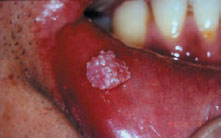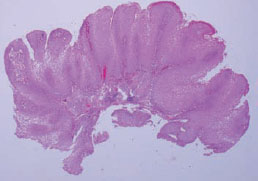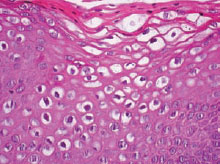26 Swellings: Infections, human papilloma virus
Figure 26.1 HPV types and their associations.

Figure 26.2 Papilloma.

Figure 26.3 HPV papilloma.

Figure 26.4 HPV koilocytes.

Figure 26.5 Oral warts.

The Human Papilloma Virus (HPV) infection is contagious when there is contact with the skin or mucosa of an infected person. Transmitted usually by close contact, often in childhood, most cause benign epithelial growths (warts), though lesions may not always be clinically evident. Skin warts typically disappear after a few months but can last for years and the virus remains and can recur especially in people who are immunocompromised as in HIV/AIDS or transplant recipients. HPV infections can also occur in the mouth and can be transmitted by oraloral or oro-anogenital contact.
There are over 100 strains of HPV (Figure 26.1). Types 1, 2, and 3 cause common skin warts: Type 1 causes warts on the soles of feet and palm of the hands. Type 2 causes common warts, filiform warts, plantar warts, and mosaic plantar warts. Type 3 causes “plane” or flat warts.
Types 6 and 11 cause anogenital warts. HPV types 16 and 18 cause about 70% of cervical cancer and are thus termed “high risk” types. A higher prevalence of HPV infections is seen in patients with other sexually transmitted infections.
Oral papillomas are far more common than warts or condylomas but the various forms of oral “warts” are clinically difficult to differentiate and have not always been typed.
Papilloma
Definition: A benign epithelial neoplasm with an anemone-like appearance.
Prevalence (approximate): Uncommon.
Age mainly affected: Adults.
Gender mainly affected: M = F.
Stay updated, free dental videos. Join our Telegram channel

VIDEdental - Online dental courses


